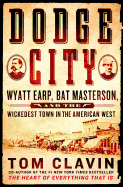
Tom Clavin (The DiMaggios) opens Dodge City: Wyatt Earp, Bat Masterson and the Wickedest Town in the American West with Masterson stepping off the train in Dodge City in Kansas, expecting trouble. The scene is tense; Clavin deliberately evokes the images of lawlessness and violence associated with the city's name.
The uneasy relationship between that violence and the creation of a system of frontier justice unfolds here. Clavin builds on the premise that most of the books and films about Wyatt Earp, Bat Masterson, Doc Holiday and Dodge City are fiction, "including the ones published as nonfiction." He sets up popular images, and then carefully dissects them in search of a measure of historic truth. (Not an easy task--legend and misinformation appeared almost immediately, thanks to the popular press, dime novels and inconsistencies in the accounts of the characters involved.) He follows his main characters, their relatives and an enormous cast of cowboys, outlaws and lawmen through their travels in and out of Dodge City. More importantly, he sets "the wickedest town in the West" in its historical context of buffalo hunting, cattle drives, westward expansion of the railroads and a national sense of manifest destiny.
The result is a colorful and careful depiction of a city in transition. As Clavin presents it, Dodge City was violent, lawless and complex. The dividing line between outlaw and lawman was fluid. And justice was a moving target. --Pamela Toler, blogging at History in the Margins

